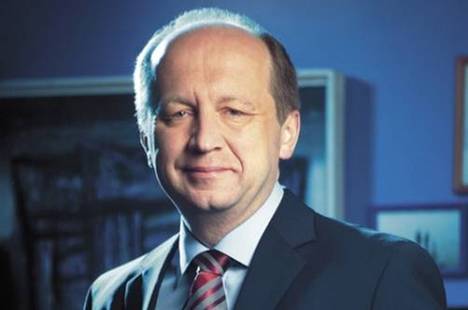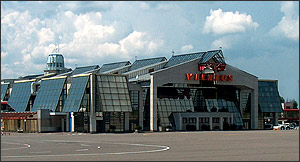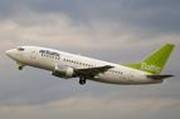
THE VOICE OF INTERNATIONAL LITHUANIA
|
VilNews has its own Google archive! Type a word in the above search box to find any article.
You can also follow us on Facebook. We have two different pages. Click to open and join.
|

Lithuania’s Prime Minister, Andrius Kubilius.
Arrogance and ignorance are not particularly positive characteristics of anyone, and I understand it well if some of our VilNews' readers, who see that I use these words together with a picture of our Prime Minister, predict that I will now be criticising him. So let me hurry to say that these two words are meant for all questionable behaviours seen performed by our governing forces since 1990, not solely for Mr. Kubilius.
I must admit that I over the past 20 years have seen a few Lithuanian leaders whose arrogance and belief in their own excellence in some cases have prevented progression and good development for Lithuania. Still today I miss leaders who are good at listening to their own Lithuanian people, wherever in the world they may live, and I miss leaders able to inspire and be unifying figures and good examples for the nation they are appointed to serve. Leaders able to lead, not only manage.
I have also very much been missing to see our leaders seek advice from other countries and its own diasporas; to learn from mistakes and experiences these nations went through during the years when Lithuania was still under Soviet rule. Instead, time after time, we have seen Lithuanian leaders trying to reinvent the wheel.
PM Kubilius' profound measures for savings and cuts during the very serious financial crisis Lithuania still experiences, is for me an example of just that. In my opinion, the type of medicine he has been using is to compare to putting the brakes on for a car that already stands still, or closing the tap when the well is already empty.
Countries in Scandinavia and North-Western Europe have the background and resources to make cuts. Lithuania and other Eastern European countries are, after the long Soviet-era economic mismanagement, not in such a fortunate situation. Here most of the resources should have been spent on finding new fuel for the car and fresh spring water for the well.
Being a Norwegian, I believe Norway and the other Scandinavian countries would have been willing to stretch to great lengths to provide help and advice for the crisis-hit Lithuania and the two other Baltic States. But they had to be asked.
Our Lithuanian leaders should refrain from arrogance and avoid ignorance by seeking advice where good help and advice is to find, domestic and internationally. Can they do that, there is every reason to foresee a bright future for this nation.
The Lithuanian people deserve exactly that. They have suffered enough.
The airport comparison

Vilnius Airport’s terminal building from 1954 was built during Stalin’s last years.
It still remains the airport’s main face towards Vilnius City.
To make my above point more understandable, I will in the following compare post-war Lithuania to Vilnius Airport. Why? Well, they have more in common than you may think; metaphorically, symbolically and representatively for what has been going on here from WWII till today.
The old airport terminal was built in the years after the war, in typical Stalin style characterised by robust constructions and materials very hard to remove. The building was completed a year after his death, in 1954. After that, the airport remained more or less unchanged through the following 40 years, with Soviet Aeroflot as the sole operator until Lithuania's independence in 1990/91.

The airport was extended in the 1990s. This is the ‘monster’ that for many
years greeted (scared) airline passengers who came to visit independent Lithuania.
In the early 1990s, the airport was starving for total renewal. A public face and symbol of the now free, independent and internationally oriented Lithuania was urgently needed. The new airport should become the pride of the new democracy and an important hub for international airlines that one thought would bring hordes of visitors to the country. Not least was it estimated that the majority of the many who had emigrated to America, Australia and other countries now would move back to their homeland and contribute actively to the country’s reconstruction.
It was therefore not long before the airport management and the transport ministry chose a group of architects and other experts to travel around the world to look at leading international airports. The airport in Vilnius should be designed on a top global level. Back in Vilnius the architects drew day and night on what would become the country's new pride, and a couple of years later the 'masterpiece' was completed.
But what a tragedy. The architects and the airport authorities had in their arrogance and self-delusions of excellence thought that to visit some prominent international airports would be a good enough background for designing and building the new terminal building. They had not bothered to seek advice from international experts. The result became a new Vilnius Airport that was confusingly similar to misguided Soviet designs, and came to be viewed rather negatively as ridiculous by the international travel industry.
The 'airport monster' in Vilnius emerged not as a glorious example of a great country developing well, as it had been planned, rather as a symbol of a country where arrogance and ignorance prevented from learning important lessons from other countries.
And it's probably just here we find the most obvious similarity between the past twenty years’ development of the airport and the country's authorities; this that those at the helm have been so convinced of their own excellence that they haven’t cared to seek advice from others.
This can, of course, to a certain extent be understood, as this country through so many years was imposed to 'advices' from others that they no longer wished to accept any outside help when the new times came.
Probably that was why we in the 1990s got a parody of an airport. Perhaps this ‘blinkers mentality’ is also a contributing factor to why this country's population still suffers from the excessive and unfair tightening measures introduced by the government, rather than enjoying stimulus packages of the kind that are leading people in other countries through the crisis along a far more smooth path?
Maybe the ongoing ‘evacuation’ from this country has much of its background in such arrogant attitudes from the side of the authorities? Maybe people would like to become part of a democratic process and a national teamwork instead of being treated with arrogance and lack of interest from their own leaders?
The airport-building from the 1990s was supposed to appear as modern, as avant-garde. Those behind it were proud of their own excellence. Seen from the outside the building appeared, however, as a parody. Many of Lithuania’s leaders over the past 20 years are surely also proud of what they have achieved. But what about the people?

In 2007 a new extension stood ready. The previous ‘monsters’ were now hidden
behind modern materials and design. Lithuania’s face to the world had finally
reached a level of maturity, hiding many of the old sins. Unfortunately only artificially.
When the 2000s arrived it began to be understood by Lithuania’s leaders that membership in the EU would not only entail benefits, but that they also had to do something for their own part, and when the Schengen Agreement was under preparation it became clear that the Vilnius Airport had to be extended. This new construction was performed quickly and efficiently. There could be no doubt that both the country's architects and contractors had learned very much since the 1990s.
So, what characterises Vilnius Airport now in 2011?
A) The core element is still a building in Stalin Style. It is also this old building's façade that appears towards the side of Lithuania and it is on this side that the taxi drivers still do their best to cheat naïve foreigners and others. The Soviet legacy is still very solid and evident in this country.
B) On the side facing the runway and the international world, there was in the 1990s conducted an ultimately unsuccessful attempt to make a building that both functionally and symbolically should be a showcase of the proud new democracy. This travesty of a building, that so well symbolizes Lithuanian authorities’ thinking for the period 1990-2007, is now hidden between the Stalin-building and the new glass building that was completed in 2007. But the parody was not torn down, and you still have to run up and down the strange
stairs, in and out of corridors and funny corners, in a maze of steel, concrete and glass produced with Soviet
technology. What should have been a prominent symbol of the new democracy was instead made a monument of stupidity, greed and lack of transparency.
The airport in Vilnius will not function well if this section is not removed completely. Lithuania will not function well until the greed culture established by its leaders of the 1990s is totally removed.
C) In the 2000s, the building from the 1990s was tucked away between the Stalin building and a new extension that was much better adapted to modern requirements and design ideas. But also this new building is just to a certain degree characterised by measures necessary to make the airport functional and representative of modern times. To mix old and new can often be complicated. To hide old sins behind new façades is more artificial than a sign of real improvements.
So the parallels between Vilnius Airport and post-war Lithuania are quite obvious, aren’t they?
The essential question then, is obviously what is now needed to achieve real change? My opinion is that there as soon as possible should be built a new airport where neither Stalin nor the monsters of the 1990s are given space or influence. We need a solid world-class airport as a proud new symbol of a progressive country - with outstanding leaders and project managers in charge – leaders accepting neither arrogance nor ignorance, neither during the planning and construction phase nor during the operation period.
My comparison between the airport and the nation is still valid. Perhaps, now, the idea of openness and transparency, plus the ability and willingness to listen and learn from others, would not be too bad an advice?
Aage Myhre, Editor-in-Chief
aage.myhre@vilnews.com
Arrogance, ignorance or…?

Airport and hotel taxes almost killed
the tourism industry.
When Kubilius' government took over in late 2008 they decided to keep the country’s airport charges at a very high level, and to triple the VAT for hotel accommodation. The result was that several international airlines dropped Lithuania as a destination and the number of travellers and hotel stays fell dramatically. Tens of thousands lost their jobs, and the country lost much needed tax dollars.
2009 was the year when Lithuania celebrated its 1000-year name day. It was also the year when Vilnius was the European Capital of Culture. Despite those positive incentives, the number of visitors to Lithuania became far lower in 2009 than in 2008, primarily due to the government's decisions described above. In 2010, however, the airport fees are reduced considerably and the airlines are finally returning, one year late. But what a sad story isn’t this, for a whole industry and the country.
![]()
What austerity looks like
The New York Times writes about Lithuania from time to time. Their article from 2010 presents a good and balanced analysis of what's happening in our crisis-ridden country. It says that Kubilius' comprehensive savings measures now appear to give results as the decline in the economy has stopped, but the article also tells of a nation where the people are suffering more and more because of these measures:
These are two of the phrases from the article:
- “Faced with rising deficits that threatened to bankrupt the country, Lithuania cut public spending by 30 percent — including slashing public sector wages 20 to 30 percent and reducing pensions by as much as 11 percent. Even the Prime Minister, Andrius Kubilius, took a pay cut of 45 percent.”
- “The psychological toll has been immense. Suicides have increased in a country where the suicide rate of 35 per 100,000 is already one of the world’s highest, local experts say.”
You find the NYT article at: http://www.nytimes.com/2010/04/02/business/global/02austerity.html
- Bookmark :
- Digg
- del.icio.us
- Stumbleupon
- Redit it
VilNews e-magazine is published in Vilnius, Lithuania. Editor-in-Chief: Mr. Aage Myhre. Inquires to the editors: editor@VilNews.com.
Code of Ethics: See Section 2 – about VilNews. VilNews is not responsible for content on external links/web pages.
HOW TO ADVERTISE IN VILNEWS.
All content is copyrighted © 2011. UAB ‘VilNews’.

 Click on the buttons to open and read each of VilNews' 18 sub-sections
Click on the buttons to open and read each of VilNews' 18 sub-sections 



I agree totally with your comments regarding the imagery and functionality of the Vilnius airport. It has always been an issue for me, having designed airports in the US. Whereas I think there may be better examples of the strange Lithuanian reticence to take advice based on knowledge not held by them, the airport as a symbolic gateway to a rapidly developing Baltic nation is a very sorry example.
[…] Read more… Category : Featured black / Front page […]